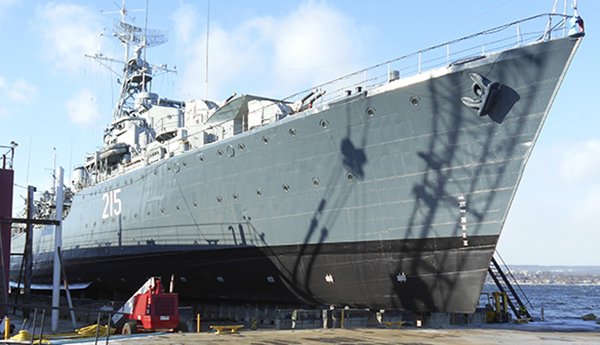Not all war heroes wear helmets and boots. In fact, some have rudders, decks and keels.
His Majesty’s Canadian Ship (HMCS) Haida had a long and impressive service record in the Royal Canadian Navy from 1943 to 1963. The retired ship was spared from the scrapyard through the determination of the citizen group Friends of HMCS Haida, who continue to act as its stewards.
In 1984, HMCS Haida was designated a national historic site and, in 2002, the ship was transferred to the custody of Parks Canada.
Since that time, it has been docked at Hamilton’s Catharine Street Pier 9 and open to the public. It attracts numerous visitors in the spring and summer months, partly because HMCS Haida has the distinction of being the world’s last survivor of a class of ships known as ‘tribal-class’ destroyers.
As we commemorate the ship’s 80th birthday, Public Services and Procurement Canada (PSPC) can reflect on over 2 decades of supporting Parks Canada with its preservation and restoration.
The path to preserving a piece of history
When HMCS Haida came into Parks Canada’s care in 2002, it had an array of problems, including holes in the hull. It was towed to a shipyard, where marine experts, alongside PSPC and Parks Canada staff, began the work needed to keep it afloat, make it safe and restore the vessel so it could be put on display. Due to time and funding constraints, a full restoration wasn’t possible at that time.
In 2015, Parks Canada had an opportunity to continue the restoration work and turned to PSPC for help in awarding and managing the contracts. “We’re not marine engineers or naval architects, but my team has a unique understanding of the industry that we could use to access suitable services and contractors for the project,” says Dan Byron, the procurement manager in PSPC’s ship refit unit.
That’s how PSPC was able to issue contracts to qualified ship restoration experts and secure a berth for HMCS Haida at the Heddle Shipyards dry dock for an assessment. Since the aging ship had to be towed to the shipyard by tugboats, competition for the contract was limited to shipyards in the area. Heddle Shipyards, which offers significant experience in the preservation of historic vessels, met all the contract requirements.

As a first step, every inch of the ship was surveyed and a report outlining priority repairs was produced. “For example, the thickness of the hull was measured using ultrasonic technology to determine which areas were of concern and needed reinforcement,” explains Byron. “Ships of this era have many issues, and we wanted to make health and safety improvements, as well as enhance the experience for visitors, so a range of repairs were carried out as part of the project.” The ship’s stability was improved, electrical systems upgraded, minor leaks addressed, and action taken to prevent further vessel corrosion.

The physical repairs were completed in 3 phases between 2016 and 2019. During the summer, the ship was able to fulfill its duty as a tourist attraction. In the off-season, it was carefully towed from the pier to the shipyard, as required, where the restoration efforts were undertaken.
While the project was a success, Byron notes that the vessel has many more check-ups in its future. “It’s a veteran of our forces that took part in several wars and provided critical service to Canada. We have to maintain and protect it, so that we never forget the ship’s, or Canada’s, significant naval history.”
A meaningful place and project
For Byron, like his team and all the stakeholders involved, the project was a dream come true:
“Everyone was excited to contribute. The ship is a legend, and we’d all heard stories about the 2002 restoration work. Also, this wasn’t a standard refit of an active service vessel. HMCS Haida is a historic artifact, so it was challenging but a great honour for our team to work on it. I remember being wowed by the ship’s interior spaces, which are a window into another era. You can picture the maps laid out on the mahogany tables and officers discussing missions and strategies. I’m pleased that we’ve made it possible for new generations to tour the ship and take this journey to the past.”


Reprinted from Parks Canada

